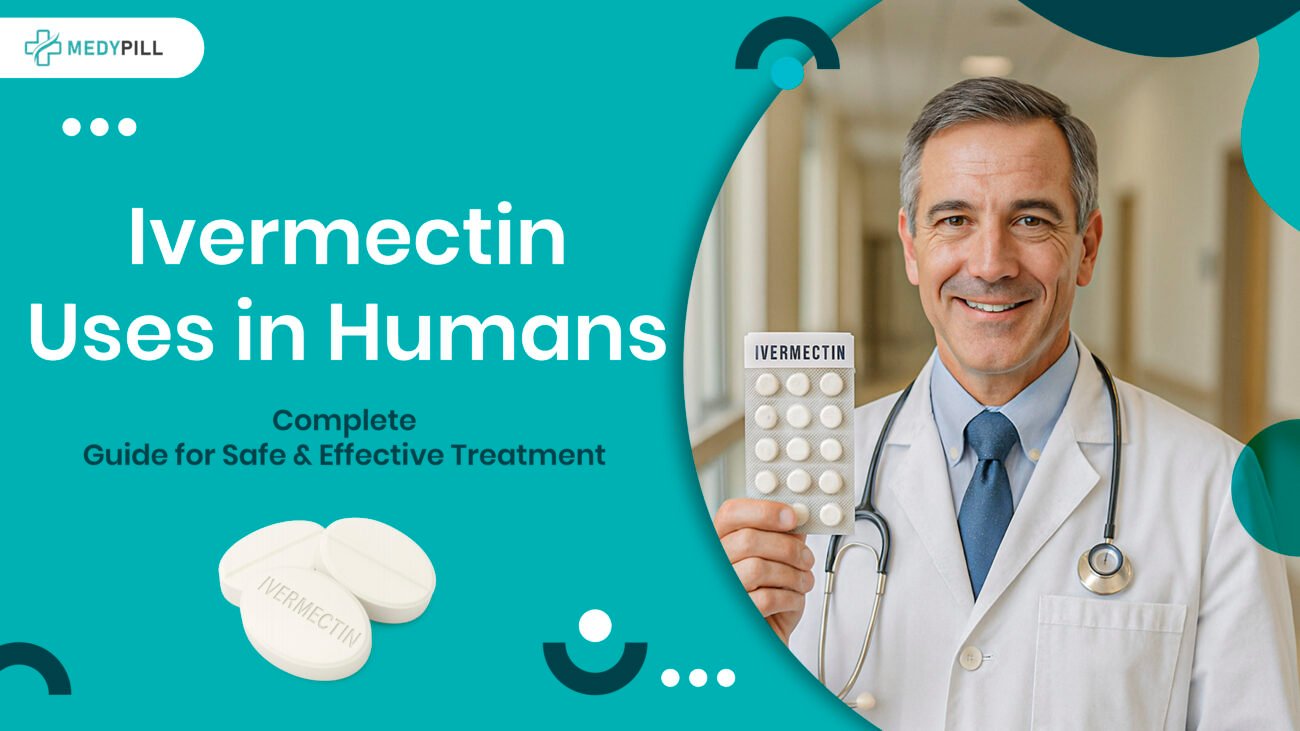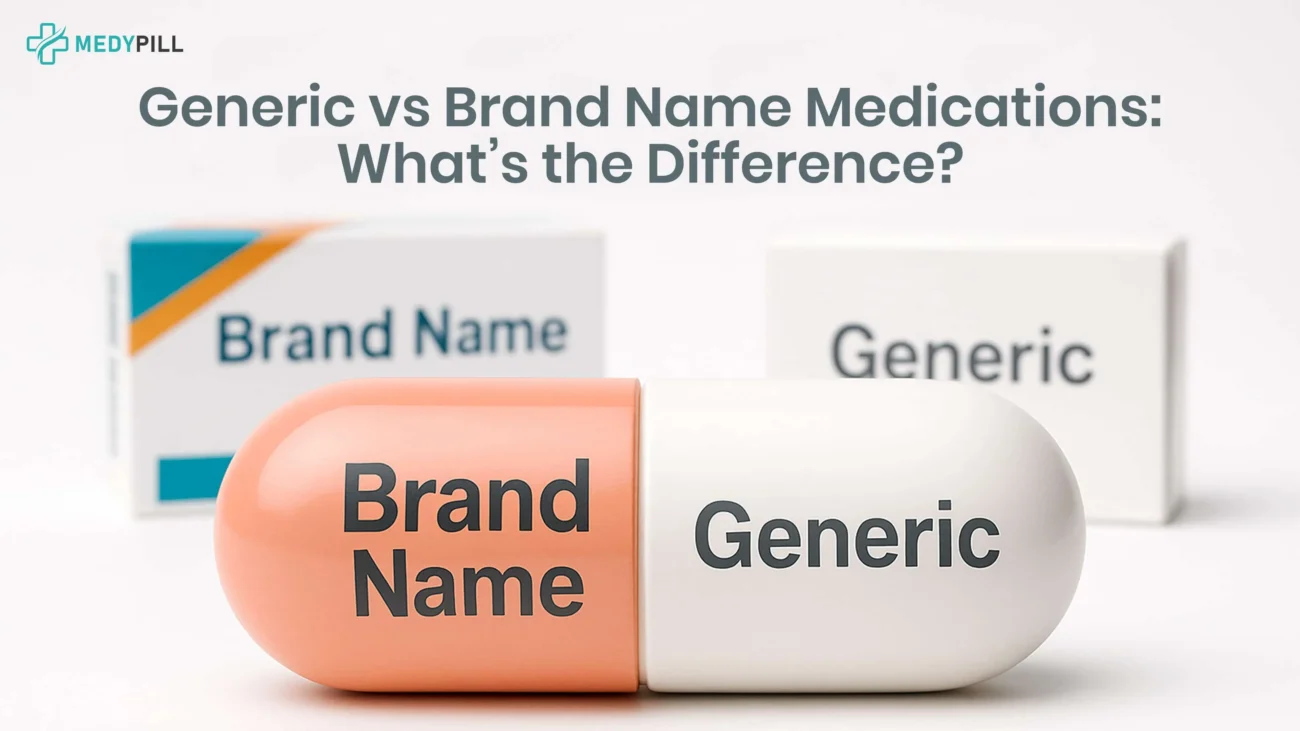
Ivermectin Uses in Humans: Complete Guide for Safe & Effective Treatment
Ivermectin is a medicine used to treat several parasitic infections in humans, such as river blindness and intestinal worms.
It was first developed from a natural bacterium found in soil in Japan. Since its approval in 1987, more than 2.5 billion doses have been administered worldwide, benefiting millions of people.
This guide explains what ivermectin is used for, how it works, how to take it safely, and what side effects to watch for.
What is Ivermectin? Introduction and Overview
Ivermectin is used to treat certain parasitic infections in people.
It targets worms, lice, and mites that cause health problems like river blindness and strongyloidiasis.
- It was first made for animals but approved for human use in 1987.
- One major study shows that a single dose of ivermectin cures strongyloidiasis in over 94% of cases.
It’s essential in countries where parasitic infections are common and part of mass treatment programs.
How Does Ivermectin Work in the Human Body?
Ivermectin works by targeting the nerves of parasites, which causes them to stop moving and die.
These nerve parts don’t exist in the human nervous system, so the medicine doesn’t harm people.
After taking it by mouth, ivermectin spreads through the body, especially in fat, skin, and lung tissues.
Related: Generic Ivermectin: Side Effects Guide
Approved Medical Uses of Ivermectin in Humans
Ivermectin is FDA-approved to treat two major parasitic infections:
1. Strongyloidiasis (intestinal threadworm infection)
- Dosage: 200 µg/kg body weight as a single oral dose
- Efficacy: Cure rates of 94.6% to 100%
- Use: Sometimes repeated in immunocompromised patients
2. Onchocerciasis (river blindness)
- Dosage: 150 µg/kg, given annually or biannually
- Mechanism: Kills larval worms (microfilariae), not adults
- Global Impact: Over 800 million doses distributed; major reduction in blindness in Africa
Ivermectin is also FDA-approved in topical form for:
- Rosacea: 1% cream (Soolantra)
- Head lice: 0.5% lotion (Sklice), for patients 6 months and older
Also: A Complete Guide to ED Medications Online Available
Additional and Ivermectin Off-Label Uses

Ivermectin is also widely used off-label for other parasitic infections:
1. Scabies
Ivermectin can treat scabies when topical creams don’t work well. The usual dose is 200 µg/kg, often followed by a second dose 1–2 weeks later.
Studies show cure rates as high as 100% in some groups. The WHO includes ivermectin as an essential treatment for scabies.
2. Head Lice (Oral Treatment)
When lice don’t respond to creams or shampoos, doctors may recommend oral ivermectin. The dose is usually 200 µg/kg, with another dose after 7–10 days.
This is helpful in cases where lice have become resistant to other treatments.
3. Lymphatic Filariasis
This disease, caused by parasitic worms, can lead to swelling and disability. Ivermectin is given along with other drugs like albendazole.
This approach is part of a global plan by the WHO to eliminate the disease.
4. Other Infections
Doctors may use ivermectin for other parasitic infections like cutaneous larva migrans (skin parasite), ascariasis (roundworms), gnathostomiasis, and whipworm (trichuriasis).
The dose and schedule depend on the infection.
5. COVID-19 (Controversial)
Although ivermectin was widely discussed as a possible treatment for COVID-19, health authorities like the FDA and WHO do not recommend its use for this purpose outside of clinical studies due to weak and inconsistent evidence.
Ivermectin for Humans Dosage: How to Take Ivermectin Safely
Ivermectin should always be taken exactly as prescribed based on body weight:
Typical Oral Doses:
- Strongyloidiasis: 200 µg/kg (1 tablet = 3 mg)
- Onchocerciasis: 150 µg/kg
Example Dosing Guide (Strongyloidiasis):
- 15–24 kg: 1 tablet
- 25–35 kg: 2 tablets
- 36–50 kg: 3 tablets
- 51–65 kg: 4 tablets
- 66–79 kg: 5 tablets
- ≥80 kg: use calculated dose (200 µg/kg)
Important Instructions:
- Take on an empty stomach with water (1 hour before or 2 hours after food)
- Most cases require one dose; some may need a second dose in 1–4 weeks
- Children: Approved for children ≥15 kg only
- Severe infections: May require daily or monthly doses in immunocompromised patients
- Alternate routes: Subcutaneous injection has been used under special circumstances
Check: What Is Stronger: Sildenafil or Tadalafil? [Evidence-Based Comparison]
Side Effects and Precautions When Using Ivermectin in Humans
Ivermectin is considered very safe when used properly, but some side effects can occur:
Common Side Effects:
- Itching (25.3%)
- Headache (13.9%)
- Dizziness (7.5%)
- Nausea, vomiting, diarrhea
- Fatigue, joint/muscle pain
Specific Reactions:
- Onchocerciasis: May cause “Mazzotti reaction” as worms die (fever, rash, lymph swelling)
- Loa loa co-infection: Can cause rare, serious neurological reactions like encephalopathy
Rare but Serious Effects:
- Stevens-Johnson Syndrome
- Toxic epidermal necrolysis
- Drug Reaction with Eosinophilia and Systemic Symptoms (DRESS)
Contraindications and Cautions:
- Pregnancy: Not recommended; teratogenic in animal studies
- Children <15 kg: Not approved
- Allergy: To ivermectin or its components
- Liver disease and CNS disorders: Use with caution
- Drug Interactions: Over 100 known, especially with CYP3A4 inhibitors and warfarin
Also, see: Sirolimus: Uses, Benefits & Treatment Info
Conclusion
Ivermectin has revolutionized the treatment of parasitic diseases and continues to be one of the most effective, safe, and affordable options available.
With proper dosing and awareness of side effects and contraindications, it remains a vital tool in global health.
However, ivermectin should only be used for approved and evidence-based indications.
It is not a cure-all, and off-label use, especially for viral infections like COVID-19, must be approached with scientific caution and medical guidance.
FAQs
Q: Is ivermectin safe during pregnancy?
A: No, it is not recommended due to a lack of human safety data.
Q: Can children take ivermectin?
A: Yes, but only if they weigh at least 15 kg (33 lbs).
Q: How long does ivermectin stay in your system?
A: Its effects can last for weeks due to tissue distribution, though its plasma half-life is about 12–38 hours.
Q: What if I miss a dose?
A: For single-dose treatments, this is rare. If on multiple doses, take the missed dose as soon as remembered unless near the time of the next one.
Q: Should I take ivermectin with food?
A: No. Take it on an empty stomach with water to ensure consistent absorption.
Q: Is ivermectin effective for COVID-19?
A: No, current research does not support its use for COVID-19 outside of clinical trials.
Q: What are the signs of overdose?
A: Confusion, dizziness, nausea, low blood pressure, and tremors. Seek immediate medical help.
Q: Is ivermectin effective for scabies?
A: Yes. It has a high cure rate and is recommended by WHO when topical treatments fail.

Aug 12, 2025
Generic and brand name medications work the same. They treat the same conditions and use the same main ingredients. The big difference is price generics…
VIEW DETAILSAug 12, 2025
Fenbendazole is not considered safe for human use according to the FDA and major medical bodies. While some people are…
Aug 12, 2025
Semaglutide helps people lose weight by lowering hunger and making them feel full for longer. It’s available as a weekly…

